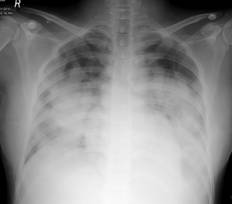H1N1 influenza: Does chest radiograph have a role in predicting prognosis?
Abstract
Aims and Objectives: To assess pattern and distribution of chest ray findings in proven case of H1N1 & To evaluate sequential radiographs to assess progression/ resolution of disease.
Material and Methods: Patients presenting to a tertiary care hospital in coastal Karnataka, India, from May 2009 to Feb 2011, who tested positive for H1N1 virus with real time PCR test and underwent chest X ray were included in the study. The pattern and distribution of findings and extent of involvement was studied in the initial chest radiograph. Sequential radiographs were studied for progression of disease.
Results: The age of patients ranged from 1 to 65 years with 11 (31.5%) patients in pediatric age group, two patients above 60 years and rest were middle age adults (62.8%). Out of 39 patients, four patients had a normal chest radiograph. In the remaining 35 patients, commonest finding was consolidation (77.1%) followed by ground glass opacity (68.6%). Thirty patients had involvement of both lungs at presentation out of which 17 improved, 12 patients expired and one was discharged on request.
Conclusion: Patients with bilateral multizonal involvement at presentation deteriorated faster and had an adverse outcome whereas patients with single zone or unilateral involvement had a better outcome. Consolidation and ground glass opacities, especially if bilateral and multizonal predicted adverse outcome. Chest radiograph can play an important role in assessing pattern and distribution of findings and may help in predicting prognosis.
Downloads
References
CD alert (webpage on the internet). India: Monthly Newsletter of National Institute of Communicable Diseases, Directorate General of Health Services, Government of India, [cited March-April 09, vol12: no8]. Available from: http://www.india.gov.in/allimpfrms/alldocs/12416.pdf.
McEwen RE, Scriven JE, Green CA, Bailey MS, Banerjee AK. Chest radiography findings in adults with pandemic H1N1 2009 influenza. Br J Radiol. 2010 Jun;83(990):499-504. doi: https://doi.org/10.1259/bjr/24252450.
Public Health Foundation of India, (homepage on internet). India: Novel Influenza A(H1N1), General information for health care workers. [Cited 2009]. Available from http://www.phfi.org/h1n1flu/index.html.
Office of the Director, Emergency Medical Relief (webpage on internet). India: Directorate General of Health Services, Government of India, New Delhi; [cited Aug 2010]. Available from http://mohfwh1n1.nic.in/documents/PDF/SituationalUpdatesArchives/august2010/Situational Updates on 29.08.2010.pdf.
Mehrdad Bakhshayeshkaram, Bahareh Saidi , Payam Tabarsi , Soheila Zahirifard Mishka Ghofrani. Imaging Findings in Patients With H1N1 Influenza A Infection : Iranian journal of Radiology, 2011 ,8(4), 230-234.doi: https://dx.doi.org/10.5812%2Firanjradiol.4554.
Perez-Padilla R, de la Rosa-Zamboni D, Ponce de Leon S, Hernandez, M, Quinones-Falconi F, Bautista E, et al. Pneumonia and respiratory failure from swine-origin influenza A (H1N1) in Mexico. N Engl J Med. 2009; 361(7):680-9.doi: https://doi.org/10.1056/nejmoa0904252.
Aviram G et al. H1N1 Influenza: Initial Chest Radiographic Findings in Helping Predict Patient Outcome. Radiology: 2010; 255:252-259.doi: https://doi.org/10.1148/radiol.10092240.
Choi J M, Lee Y S S, Lee J Y, Lee K S. Novel Influenza A (H1N1) Virus Infection in Children: Chest Radiographic and CT Evaluation. Korean J Radiol 2010;11:656-664.
L Abbo L, Quartin A, Morris M I, Saigal G, Ariza-Heredia E, P Mariani, Rodriguez O, et al. Pulmonary imaging of pandemic influenza H1N1 infection: Relationship between clinical presentation and disease burden on chest radiography and CT. The British Journal of Radiology, 2010,(83) 645–651.doi: https://dx.doi.org/10.1259%2Fbjr%2F53692814.
Nicolini A, Ferrera L, Rao F, Senarega R, Ferrari-Bravo M. Chest radiological findings of influenza A H1N1 pneumonia.Rev Port Pneumol. 2012;18(3):120-7.doi: https://doi.org/10.1016/j.rppneu.2011.12.008.
Nizar A. Al-Nakshabandi. Determining symptoms for chest radiographs in patients with swine flu (H1N1), Pol J Radiol. 2011; 76(4): 45–48.https://www.ncbi.nlm.nih.gov/pmc/articles/PMC3389947/.



 OAI - Open Archives Initiative
OAI - Open Archives Initiative


